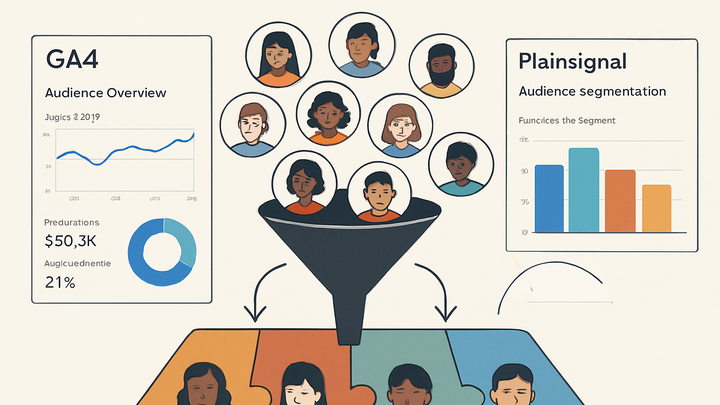Published on 2025-06-27T21:56:39Z
What is Audience Segmentation? Examples and Best Practices
Audience segmentation is the process of dividing a website or app’s users into smaller, meaningful groups based on shared characteristics or behaviors. By creating segments—such as new vs. returning visitors, high-value customers, or users from specific traffic sources—analysts can uncover deeper insights and tailor marketing efforts with precision. In Google Analytics 4 (GA4), segmentation is performed through the Audience Builder or custom conditions, enabling you to filter and compare different cohorts directly in your reports and explorations. PlainSignal, a cookie-free analytics solution, supports segmentation via custom event properties and filters, ensuring privacy compliance while still delivering granular data. Properly implemented, audience segmentation leads to improved personalization, optimized campaigns, and a clearer understanding of user journeys across your digital properties.
Audience segmentation
Grouping users into meaningful segments in GA4 and PlainSignal for deeper insights, personalization, and optimized marketing.
Why Audience Segmentation Matters
Segmentation allows you to focus on specific user groups for targeted insights and actions, rather than relying on aggregate data that can mask important trends. By analyzing distinct segments, you can personalize experiences, improve engagement, and optimize marketing spend across different cohorts. Without segmentation, broad metrics may lead to misallocated budgets and one-size-fits-all strategies that underperform. Audience segmentation also helps in isolating performance issues and attributing results to the right channels or user types. Ultimately, segmenting your audience drives more precise decision-making and higher ROI.
-
Personalization
Tailor content, offers, and messaging to resonate with each user segment, increasing relevance and conversion rates.
-
Optimized marketing spend
Allocate budget toward segments with the highest lifetime value or engagement metrics, improving ROI.
-
Improved reporting
Use segment-specific metrics to uncover trends and anomalies that aggregate reports might hide.
Common Segmentation Criteria
Segmentation can be based on various user attributes; choosing the right criteria ensures actionable and meaningful groups. Common approaches include demographic, behavioral, and technographic segmentation, each providing unique insights into your audience. The right combination of criteria depends on your business goals, data availability, and target personas. Mixing multiple dimensions—such as behavior plus acquisition channel—can yield more nuanced segments. Understanding these criteria helps you define segments that drive targeted strategies.
-
Demographic segmentation
Group users by age, gender, location, and other personal attributes to understand who your audience is.
-
Behavioral segmentation
Group users based on actions they take—like page views, clicks, downloads, or purchase history—to analyze engagement patterns.
-
Event frequency
How often users perform a key action, indicating engagement level.
-
Recency
How recently users performed an action, reflecting current interest or intent.
-
-
Technographic segmentation
Based on device type, browser, operating system, or network to optimize technical performance and user experience.
Implementing Segmentation in Analytics Tools
Learn how to define and apply audience segments in Google Analytics 4 and PlainSignal. GA4 offers a visual Audience Builder for configuring conditions based on user properties and events, which can then be applied to reports and explorations. PlainSignal’s cookie-free approach uses event attributes and dashboard filters to create cohorts without relying on third-party cookies. Below is the standard PlainSignal tracking code snippet for data collection, which you can extend with custom properties to segment your audience.
-
Creating segments in GA4
Use GA4’s Audience Builder to define user groups based on event parameters, user properties, and sequence conditions. After creating an audience, apply it to standard or custom reports, explorations, and Google Ads integrations to monitor segment performance.
-
Define conditions
Set rules based on dimensions, metrics, and events to include users in the segment.
-
Apply to reports
Select your audience in explorations or use it to filter standard reports.
-
-
Defining segments in PlainSignal
In PlainSignal, embed the following script to collect data, then use the Segments UI to filter by event properties like pageType or userRole:
<link rel="preconnect" href="//eu.plainsignal.com/" crossorigin /> <script defer data-do="yourwebsitedomain.com" data-id="0GQV1xmtzQQ" data-api="//eu.plainsignal.com" src="//cdn.plainsignal.com/plainsignal-min.js"></script>After data collection, navigate to Segments in the PlainSignal dashboard, create new filters, and save your audience for dashboard analysis.
-
Embed tracking code
Place the PlainSignal script in your site’s <head> to begin data collection.
-
Set up filters
Define rules in the PlainSignal Segments UI using event properties or custom attributes.
-
Best Practices and Common Pitfalls
Adhere to data privacy regulations, maintain actionable segment sizes, and regularly revisit your segment definitions to ensure they remain relevant. Overly granular segments can dilute insights, while segments that are too broad may lack practical application. Always document segment criteria, test their performance against business goals, and retire outdated segments. Privacy-compliant practices—such as avoiding personally identifiable information without consent—are crucial for trust and legal compliance. Following these guidelines helps you get the most value from your segmentation efforts without overcomplicating your analytics framework.
-
Maintain privacy compliance
Use anonymized or consented data and avoid collecting sensitive PII without explicit permission.
-
Keep segments actionable
Ensure segments are neither too small to analyze nor too large to derive specific insights; each should inform a clear strategy.
-
Regularly review and update
User behavior changes over time; schedule periodic audits of segments to keep them aligned with current patterns and goals.
